User:Tony Rodi
Preface
[edit]The following content of this user page is in part and in nature autobiographical
because the user was an integral performer in the issues covered, and the reason that
the user is a suitable person to be an editor on pages which cover those topics.
The issues covered include three of the most significant cultural and historic urban
developments in Australia.
Tertiary education
[edit]1971 - graduated with a Bachelor Of Science degree in the Faculty of Architecture at the
University of New South Wales and later, in 1981, a Bachelor of Architecture .
1971 - employed at the Commonwealth Experimental Building Station at North Ryde,
http://trove.nla.gov.au/work/166006790?q&versionId=180924781.
Employed to take charge of the Light Laboratory, duties included the use of the
Station's Solarscope, and artificial sky, for shadow and sunlight penetration analysis,
and wind tunnel testing for skyscrapers, and the design of the station's acoustics laboratory.
http://trove.nla.gov.au/work/38390814?q=Solarscope&c=book.
New Parliament House Canberra
[edit]
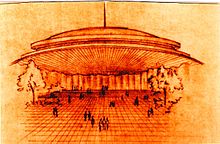
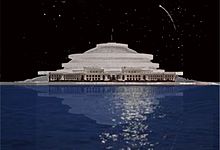
Walter Burley Griffin won an international competition for the design of Australia's new political capital, Canberra. The concept for the capital envisioned a prominent display of the Capitol building on top of Capital Hill, a symbol of the people's dominance over the parliament of a democratic nation. Both the original concept and the hill, were demolished when twenty one metres were taken off the top of Capital Hill, in preparation for the construction of a building designed for a flat site, thus reversing the concept of a people's parliament.
Entry 301
[edit]
1979.
Paul Henry Johnson, proposed a visionary design for a new parliament house on Canberra's Capital Hill.
He was joined by Tony Rodi, who prepared architectural plans for presentation for an international competition for the design of the new building.
Together, they developed a proposal to utilise active and passive solar energy systems for internal climate control,
and to optimise energy efficiency, using renewable resources, and clean technologies.
In 1979 then, they submitted a proposal for a revolutionary solar design for the new Canberra Parliament House.
This concept, both in solar design and political philosophy, was implemented in the German Parliament’s dual layered glass dome, climate control technology.
In 1999 British Architect Laureate, Sir Norman Foster, was awarded the International Pritzker Prize for Architecture for the redesigned German Parliament House,
the Reichstag, currently proclaimed as the greenest building on earth.
"The most original design for the new Canberra Parliament House".
The Sun Herald 25th January 1981.
Revolutionary Solar Design
http://up.wiki.x.io/wikipedia/en/3/3c/New_Parliament_House_Canberra_Revolutionary_Solar_Design.jpg
View across Lake Burley Griffin from Regatta Point.
[edit]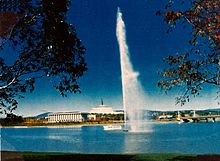
.
View of Capital Hill from across Lake Burley Griffin, at Regatta Point, shows a prominent display of the apex of the Parliamentary Triangle, as Walter Burley Griffin had intended.
Aerial view over Capital Hill.
[edit]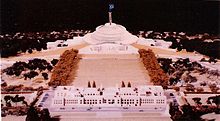
Capital Hill, with an altitude of 605 metres above sea level, was chosen for the location of the Capitol building, a concept which highlighted the people's dominance over the parliament. Parliament House was to be located on Camp Hill, where the original parliament building was constructed for the opening of Parliament House in May 1927. http://en.wiki.x.io/wiki/File:Parliamenthouse2.jpg The concept was reversed and Capital Hill was demolished along with the original concept for a people's parliament. Malcolm Frazer, the then Prime Minister of Australia, who decided on an international competition for the new building, expressed his disappointment for the winning entry.
http://en.wiki.x.io/wiki/File:Photo_of_the_new_parliament_house_from_Capital_Circle,_Canberra.jpg
Sydney Opera House Precinct- East Circular Quay (Bennelong Point)
[edit]
"Thousands join fight to save East Circular Quay" https://archive.is/uJtpC/b1946f8be8242e3cbfe903444ab46cb82eb85da1 "The desecration of East Circular Quay strikes at the nation's psyche ... Australia's most hated building must go.'" (Sydney architect Mr Tony Rodi, the convener of the Save East Circular Quay Committee,and Architect of the Majestic Gateway proposal, in Totaro P, smh_98.05.16) Sydney Morning Herald))
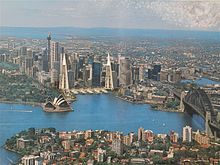
- again an alternative with the Botanic Gardens extended over the East Circular Quay site to Sydney Cove.
Before his death, Lionel Todd, commented when asked about whether corruption
played a role in the development of East Circular Quay (Sydney Opera House Precinct), saying :-
"Well, I don't know what else you would call it."
Commercial Development versus Heritage
[edit]The Gateway Site and East Circular Quay.
[edit]Tempest Swirls around Sydney's Landmark Opera House. http://www.csmonitor.com/1998/0717/071798.feat.feat.11.html/(page)/3
The Landing Site Of the First Fleet (26th of January 1788) at Sydney Cove, and East Circular Quay - Sydney Opera House Precinct.

A proposal by Sydney Opera House Stage 3 Architect, Lionel Todd and Associate Tony Rodi,
envisaged a revitalised Circular Quay which respected both the Sydney Opera House Precinct,
and The Landing Site Of the First Fleet, referred to as The Gateway Site.

- The Semi-Circular Quay proposal showed landscaped plazas to the north, extended an extra twenty four metres.
- Landscaped plazas south of the Cahill Expressway, in front of Customs House, along the length of Alfred Street,
- Landscaped roof terraces over restaurants and cafes, linking with the Botanic Gardens over Macquarie Street,
- Leaving clear views of the Sydney Opera House from the main pedestrian approach.
The proposal envisioned the demolition of Circular Quay railway station, and relocation of an entire transport interchange
below plaza level, allowing for four ferry wharves at plaza level.
In 1981 a major submission to Sydney City Council for The Gateway Site was made by the Quayhole Committee, Paul Johnson and architect Tony Rodi.
Their Gateway proposal relocated a proposed 44 storey tower development off the site to form a monumental symbolic gateway to Australia. The site itself could then be restored to a naturalistic shoreline with original Tank Stream inlet in a Memorial Park. There it was proposed to enact a treaty between the Indigenous Australians and the Australian Government. In a radio interview Mundey referred to the Quayhole Committee as "Visionary Architects" for their proposal. Later he was elevated to chairman of the planning committee of Sydney City Council from May 1984 to September 1985.[citation needed]
THE Landing Site Of the First Fleet (26th of January 1788) where
Captain Arthur Phillip raised the Flag on the first Australia Day.
http://commons.wikimedia.org/wiki/File%3AFoundation_Of_Australia_Plaque.jpg
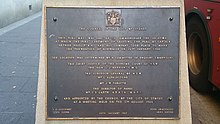
In 1994 the Anti-Wall Committee was formed to protect the Sydney Opera House from nearby urban development. In 1997 the "Save East Circular Quay Committee" was convened by Tony Rodi and Paul Johnson, and chaired by Neville Gruzman, and later by Jack Mundey in the battle to stop the desecration of the Sydney Opera House precinct.Totaro, Paula (16 May 1998). "'The desecration of East Circular Quay strikes at the nation's psyche ... Australia's most hated building must go.' Sydney architect Mr Tony Rodi". The Sydney Morning Herald. Jack Mundey, Doug Sutherland, Lionel Todd (Stage 3 Sydney Opera House Architect), and Kell Hutchence, joined the battle, urged by an unprecedented public outcry against an apartment development, which obliterated views of the Sydney Opera House from the main pedestrian approach. In the final stages, the controversial development attracted international attention which included The New York Times and Christian Science Monitor.[1] The resulting development of Bennelong Apartments (coined as The Toaster) dominates the eastern shore of Circular Quay and is highly controversial for its positioning, encroachment onto previously public space, and mediocre design quality, and primarily for obscuring views of the Sydney Opera House, from the main pedestrian approach.[citation needed]
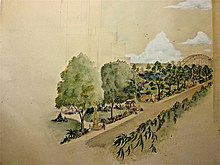
https://firstfleetfellowship.org.au/first-fleet-fellowship/australia-day/
The actual landing site is now located in the basement carpark of a 44 storey commercial tower built by the Hooker Corporation.
A flag commemorating Captain Arthur Phillip's declaration of the establishment of the new British Colony is located at the bus stop adjacent to Customs House, Circular Quay.
Supporters.
Clover Moore is an Australian politician. She has been the Lord Mayor of the City of Sydney since 2004. She was an independent member of the New South Wales Legislative Assembly from 1988 to 2012, representing the electorates of Bligh (1988–2007) and Sydney (2007–2012).[3] Moore is the first popularly elected female Lord Mayor of Sydney.[4]
Jack Mundey was elected to Sydney Council as representative of Gipps Ward on 14 April 1984 and served until 1987.
He was chairman of the Planning committee from May 1984 to September 1985.
Peter Collins, New South Wales State opposition leader of the Liberal Party (at the time), opposing Labor Premier Neville Wran, and Bob Carr, Minister for Planning and Environment.
Research and development
[edit]Direct Use of the Sun's Energy.
[edit]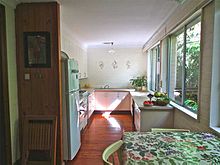
Mirror Power.
[edit]The use of the Solarscope for shadow and sunlight penetration analysis, led to the concept of using reflected sunlight
directed to actual building fenestration for lighting and warmth during the winter months, and at any other time deemed necessary.
Publication of the concept in Sydney's Sunday Telegraph newspaper, was followed by several worldwide developments using the concept
over the following months and years, with the most ambitious being the use of mirror arrays to produce thermovoltaic conversion
for large scale electricity production.
Mirror Power and sunlighting of buildings.
[edit]1988. Experimentation using mirrors to reflect direct sunlight into the house.
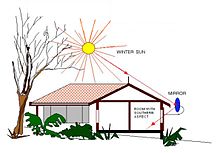
1992. Construction and implementation of cable controlled reflected sunlight from
a circular mirror mounted at the rear of south-facing kitchen, dining, and living areas.
Prototype construction costs were easily outweighed by free sunlight and much improved
mid-winter ambience.
"Mirrors direct light into darkest rooms" Sunday Telegraph 29th November 1992.
http://up.wiki.x.io/wikipedia/en/7/73/Sunday_Telegraph_mirror_article_clip.jpg
Climate Change
[edit]Towards A New Consciousness
[edit]Undergraduate thesis 1974-1975 University of New South Wales, Faculty of Architecture, Australia. "Towards A New Consciousness" .... University Library - under the category of Energy Conservation.
Subject of thesis
[edit]Climate Change
and
Alternative Energy sources to provide clean, renewable energy from Sun, Earth, Ocean, and Wind.
http://esvc000120.wic020tu.server-web.com/MyImages/Climate-Control.jpg
The thesis explored various solar energy technologies, including photovoltaic (photoelectric and thermoelectric) conversion, solar hot water, concentrated solar heating using parabolic reflectors, and direct use of the sun for heating via thermal mass and rock pile heat storage, using convective circulation. Wind turbines using kinetic energy converted to electricity were also mooted to hold extensive use potential, to be considered in conjunction with anaerobic digestion or fermentation, for methane production, hydroelectric systems including hydroelectric dams, tidal power and wave motion. Geothermal heating also held potential in appropriate locations in cooler climates. The general idea was to investigate existing renewable energy technologies which could be developed to replace unsustainable practices, (burning fossil fuels}, which would eventually be depleted in the process of destroying the atmospheric conditions that enabled relatively stable and reliable climatic conditions. A graphical examination of resource depletion, along with exponential increase in pollutant and heat emission, determined a "guesstimate" of critical effects which could lead to dangerous climate change. The critical graphical point was determined to be during the mid 1980s, although there appeared to be anomalous climatic events starting from the early 1970s. In early 1974 The Sydney Morning Herald newspaper headlined, " World weather goes haywire". By the end of the decade the United States of America had already experienced two consecutive winters of partial subarctic conditions, amongst many other climatic extremes. Ozone depletion from the use of chlorofluorocarbons, and carbon dioxide emissions, were already of serious concern to atmospheric scientists. Vast ozone depleted areas over Antarctica and southern Australia were detected by 1985.
Climate change consequences from the use of fossil fuels with carbon dioxide and heat emissions, amongst a plethora of other atmospheric contaminants, projected (estimated), to become self evident within a decade of writing the thesis. Tony Rodi claimed that a climate catastrophe was imminent and a crisis point had already been reached.
1974/75 Undergraduate Thesis for a Bachelor of Architecture degree at the University of New South Wales, Faculty of Architecture, "Towards a New Consciousness", By Anthony Francis Rodi, University Library.
In Chapter 1, 1.1 THE THESIS re.- exponential depletion and burning of fossil fuels for energy :- " they are altering earth's environment by their pollutant qualities, to a point where human survival is threatened".
and later in {1.3) Meaning of Organic. re:- environmentally destructive and socially alienating energy sources.
"If we cannot realize this intellectually, and adopt radical programmes for change practically, there is little chance that the human race can survive past the next decade without a major catastrophe."
The year is now 2017 and the evidence is increasingly pointing to a much faster than anticipated tipping point for dangerous climate change.
The most recent observations of increasing frequency and severity of climatic events indicate that climate change modelling has underestimated
the time scale for catastrophic climate change, intimating that other, unknown factors are at work.
On Monday 9th of August 2021, The Intergovernmental Panel on Climate Change (IPCC) announces a Climate Crisis, saying:-
"Climate change is widespread, rapid, and intensifying, and some trends are now irreversible, at least during the present time frame, according to the latest much-anticipated Intergovernmental Panel on Climate Change (IPCC) report, released on Monday. Human-induced climate change is already affecting many weather and climate extremes in every region across the globe. Scientists are also observing changes across the whole of Earth’s climate system; in the atmosphere, in the oceans, ice floes, and on land."
In 1974, in Sydney, Australia, the Sydney Morning Herald headlined "World's weather goes haywire." The world's weather has been haywire since. The coastline of New South Wales had been reshaped and the city of Darwin was destroyed by a cyclone on Christmas Eve of that year. The next four decades saw unprecedented climatic extremes globally, and the debate about whether climate change is real, is still in progress.
Gallery
Heritage Conservation in Australia
[edit]
September 2017
Recent decades have seen the greatest decline in the protection of the built environment,
with political control overseen by greed and vested interests, having become increasingly one-sided.
Although attempts have been made via periodically reviewing the Development Control Plan (DCP) for Ashbury,
to maintain aesthetic character, by enforcing rulings which dictate that new work and additions be located to the rear
of the dwelling, failure to dictate aesthetic compatibility, has resulted in a smorgasbord of blatantly visible aberrations.
"The Emperor Wears No Clothes".
Ashbury, New South Wales
[edit]
http://en.wiki.x.io/wiki/Ashbury,_New_South_Wales

Ashbury, Heritage Conservation Suburb
[edit]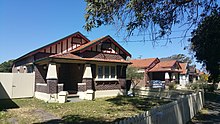
The predominant Architectural Style typifying this Sydney suburb named
"Ashbury", is "Californian Bungalow".
http://en.wiki.x.io/wiki/File:Californian_Bungalow_Streetscape.jpg
Built in the nineteen twenties, the original allotments were occupied by single storey,
single dwellings, which were designed and constructed using a variety of repeated floor plans.
The Architectural forms featured mostly gabled and hipped roofs, covered with unglazed red terra cotta tiles.
The gables were clad in fibrous cement segmented with vertical timber strip covers.
Generous verandahs and leadlight windows were also commonly featured.
Timber-Framed awnings with decorative timber brackets also enhanced elevations
and exposed rafters, dressed-all-round (DAR), added to the character and attractiveness
of the homely surrounds.
External timber sills were often supported by corbelled brickwork, adding a three dimensional
protrusion of the windows externally, and the opportunity for a recessed bay internally.
This in turn could be used for flower arrangements or placement of ornaments.
Awning windows with high sill heights would allow for natural ventilation,
weather protection, and security all at the same time.
Tuckpointing on manganese or liver coloured face bricks on front elevations was featured,
whilst side elevations were finished in common bricks set in lime mortar.

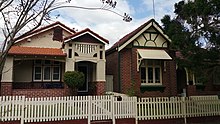


Federation and Inter-war Period Architecture
[edit]
Other architectural period styles include Federation,(early 20th Century),
and inter-war dwellings of the nineteen thirties.
Some Federation Period dwellings included roughcast rendered gable faces and brick piers.(See photo)
Tulips were often incised in decorative timber fretwork, whilst elaborate floral leadlights graced
front and side elevations.
Prior to listing the entire suburb for heritage conservation,
many of the houses were modified and added to,
with little or no consideration for either scale or style of the original architecture.
This was a direct response from increasing demand for larger spaces, and pandered to by Local Government,
in clumsily construed Development Control Plans. (DCP's)

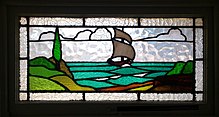
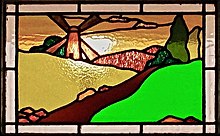
Original single storey, single dwellings, were replaced by environmentally and socially
destructive larger buildings, mostly designed without consideration for overshadowing
or privacy for neighbouring properties.
Leadlight windows were designed in the Art Deco style, which is beautifully reflected in the many
diverse geometric patterns, typical of the 1920s and 1930s.
This manifested as a direct divergence from the floral designs of the preceding Federation Period
from the first two decades of the 1900's.
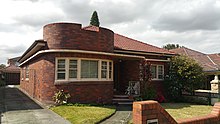
This artistic approach to home design, was to be reflected in the many variations of detailed elements
defining the Australian adaptation of the Californian Bungalow.
Picture rails, ceilings, leadlight windows, chimneys and chimney pots, terra cotta tiles and finials,
enriched the architecture, the homes and their occupants.

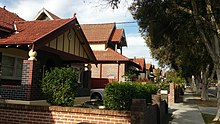
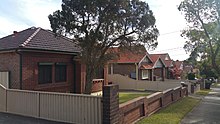
Inter- war Period dwellings were marked by the more austere hipped roofs, replacing gables,
with leadlights being geometrical and without colour, and brickwork featuring inset textured,
or herringbone designs.
Some of the houses also included curved brick walls, and Art Deco ironwork of the Universal Style.
The single storey, single dwelling streetscape has been largely retained in Ashbury.
Where 1st floor additions have been allowed, under the Local Government's Development Control Plan,
few have been designed to compliment the original architecture.
Most have been designed without aesthetic, environmental or social considerations adhering to a bygone era.
Prior to the implementation of Development Control Plan, supposedly to protect "heritage",
again, most additions or new dwelling were neither complementary in scale, style, environmental or social aspects.
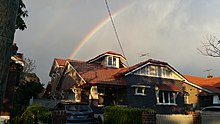
REFERENCES
1. http://www.canterbury.nsw.gov.au/Lists/Search-Results-page?q=heritage%20conservation
2. http://ashburycommunity.org/heritage-conservation-area/
4. https://www.legislation.nsw.gov.au/#/view/EPI/2012/673/historical2016-01-27/sch5
| This user is interested in Australia. |
| This user is interested in the Australian state of New South Wales. |
- ^ "Tempest Swirls around Sydney's Landmark Opera House". Christian Science Monitor. 17 July 1998. p. 3.
